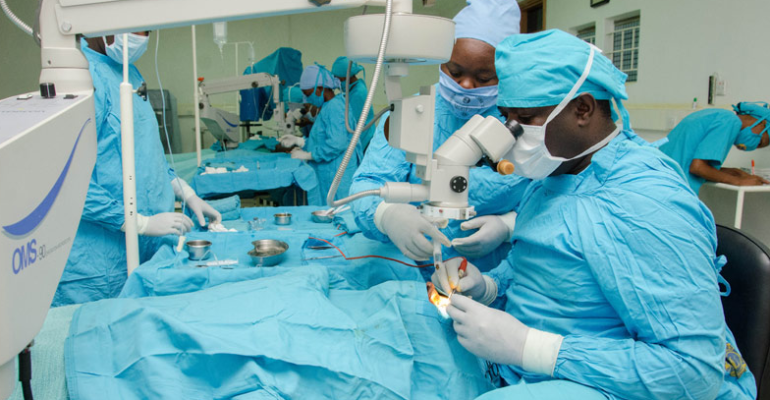Lions SightFirst Eye Hospital in Nairobi Kenya, which began as a small clinic with just 20 beds and 1 doctor in 1997, has now grown to become the forefront of optometric and ophthalmic services in East and Central Africa.
The Hospital has taken care of over 1.2 million people’s eyes and conducted over 400,000 free of charge cataract surgeries. The hospital also offers a range of eye-care services from diabetic retinopathy, corneal transplants, retina services and glaucoma treatment. On average, the hospital treats 400 patients daily of which around 300 are patients whose treatment is subsidised.
I spoke with Dr. Manoj Shah, a founding member of the Lions SightFirst Eye Hospital and who currently is the Vice Chairman, about the work the Eye Hospital does and what it’s hoping to achieve in the future.
What would you say is the primary mission of the Lions SightFirst Eye Hospital?
We aim to eliminate preventable and treatable blindness by offering equitable and comprehensive patient care, sight enhancement and rehabilitation services including related selected specialised services.
How did you come to be involved with the Lions SightFirst Eye Hospital?
I have always been passionate about healthcare services, and I began working in eye care by travelling around the country holding eye camps to screen and help people. I was also involved with the Lions Club which globally runs the SightFirst programme, and was able to help set up this multi-speciality Hospital with their support.
A huge achievement of the Hospital has been the development and running of an eye bank, could you explain what this is and why it is an important resource for the region?
The Eye Bank was set up in response to the huge need for corneal grafting to resolve eyesight problems, children in particular often benefit from cornea transplants. Due to different religious beliefs and customs, cornea donations are not common and therefore an Eye Bank of this kind has not been previously established.
The Eye Bank harvests corneas from the deceased 6 hours after death, these corneas are primarily donated by the Indian community in Kenya. Our Eye Bank Technicians then processes the corneas for suitability to be implanted.
Being the only eye bank in East Africa, it serves patients not only from the region of East and Central Africa but also from as far as Nigeria and Cameroon. Kenya alone has about 100,000 patients waiting for these sight-saving corneas. Corneal transplants that are outside of the affordability of people are provided free of charge.
What is one of the most significant sight-care projects that you have been involved with?
Partnering with WHO and Sightsavers, we worked towards near-elimination of river blindness in Kenya and seven other countries. The first phase was two years of eye-case advocacy and education, alongside the subsequent Pfizer medication distribution phase of three years. River blindness tends to occur in people living around water bodies due to a flu that infects the eye and can cause blindness.
What programmes are in place to support vision related treatment for people from socio-economic backgrounds that might not otherwise be able to afford treatment?
The hospital runs the most comprehensive outreach programme in Kenya, every Monday and Thursday, where two teams go out to a radius of 250 kilometres from Nairobi and screen patients for eye ailments.
The hospital also has the Sight for Kids Programme, which began when I noticed children doing poorly at school due to vision problems during my visits to various schools around Kenya. The programme gives free medication, glasses and eye surgeries to pupils in Low-Cost Public Primary schools in informal settlements and in the rural areas. Teachers are also trained to identify eye problems and refer the students accordingly. We have been able to help almost 400,000 children so far.
The Community Outreach Programme and the Sight for Kids Programme above serves rural areas out of Nairobi. Also, the hospital has satellite clinics in towns like Nyeri which serves the central and eastern parts of the country. Plans are also at an advanced stage to establish a hospital in Kisumu to serve western side of the country.
What are some of the ways you’ve had to adapt during the pandemic?
Due to the government Covid-19 restrictions, and to safeguard all our staff and the patients, the hospital procured PPEs, infrared forehead thermometers to take temperatures for anyone visiting the hospital and its satellite clinics, installed hand washing stations, installed transparent screens on our diagnostic equipment like the slit lamps and created a waiting hall for the patients so that the clinics can maintain social distances.
For the Sight for Kids programme, since the public schools were closed, the hospital started eye screening camps in shopping malls and at the satellite clinics specifically for children. Also, since most of the hospital’s community outreach programmes are held in churches and other religious halls, the number of those attending the camps is being limited to comply with the government regulations.
The Eye Hospital runs on a self-sustainable model, could you elaborate further on this?
The Hospital operates on a “Robin Hood Model” or composite model in which 80% of services are offered for free or at a subsidised rate. This is supported by paid services in the executive clinic that makes up the final 20% of conducted services. These funds from the payment by financially able patients alongside donations from well-wishers supports the free wing of the hospital.
All members of committees including the board of the Hospital that work to support the running and development of the Hospital work on a voluntary, unpaid basis.

